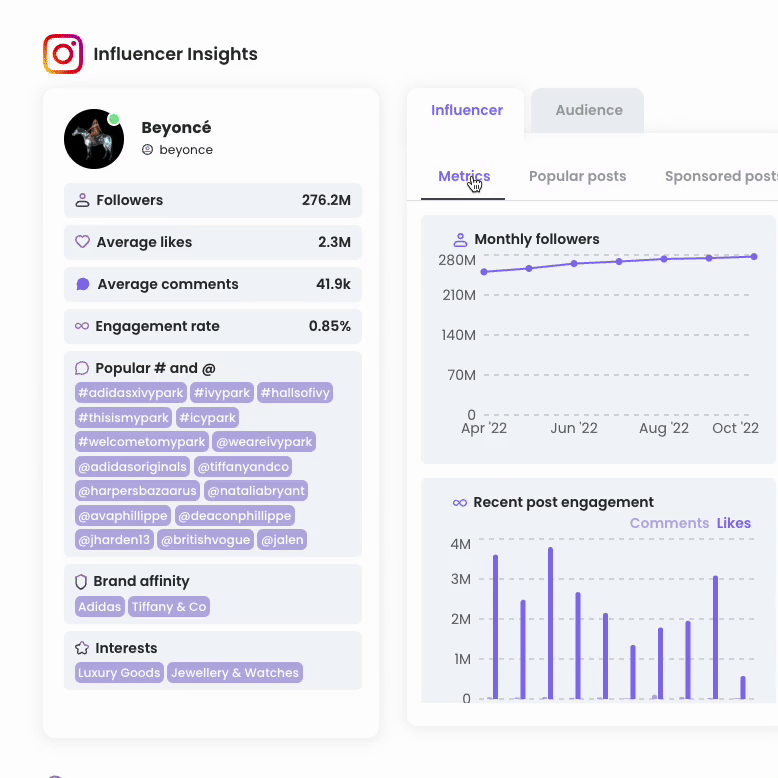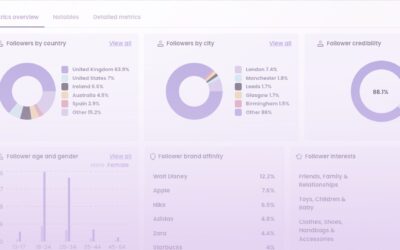Influencer marketing has emerged as a powerful tool for brands seeking to enhance their visibility and connect with a broader audience. This comprehensive guide aims to answer your burning questions about using influencer marketing to skyrocket brand awareness. Let’s get started 🙌🏼
Why are influencers important for brand awareness?
Influencers play a crucial role in brand awareness for several compelling reasons, leveraging their unique ability to connect with audiences in ways that traditional advertising often cannot.
🤍 Authenticity and relatability. Influencer content often feels more genuine and less like traditional advertising, fostering a sense of trust between the influencer and their audience. This authenticity is invaluable for brands looking to establish a credible and relatable image.
🤍 Engaged audience. Influencers have amassed significant followings on social media platforms. Whether macro-influencers with millions of followers or micro-influencers with a niche audience, they provide brands with access to diverse and targeted demographics. This broad reach is instrumental in introducing a brand to new audiences and potential customers.
🤍 Social proof. When an influencer endorses a product or brand, their followers perceive it as a personal recommendation. This social proof carries significant weight and can influence the purchasing decisions of their audience.
Moreover, influencers are often trendsetters within their niches, making them powerful conduits for introducing and popularizing new products or brand messages.
🤍 Adaptation to ad-blocker trends. As ad-blocker usage increases, influencer marketing becomes a more effective way to reach audiences. Influencers are often viewed as content creators rather than advertisers, making their content more likely to be seen by users who actively avoid traditional ads.
In summary, influencers bring a unique blend of authenticity, reach, engagement, and relatability to brand awareness campaigns – which makes it a cost-effective marketing channel for driving brand awareness.
When to use influencer marketing for brand awareness?
🤍 Launching a new product or brand
If you’re introducing a new product or launching a new brand, influencer marketing is a must to create a buzz in the market. Utilize influencers to generate excitement, enhance your brand’s initial visibility and reach a larger audience quickly.
🤍 Rebranding or repositioning
Another use case for influencer marketing would be when your brand is undergoing a transformation, whether it’s a rebranding initiative or a shift in positioning.
Collaborate with influencers who align with your new brand identity. Their endorsement can help communicate the changes effectively, reaching both your existing audience and potential customers who resonate with the influencer.
🤍 Target a specific audience
Influencer marketing is an amazing marketing channel to tap into a specific niche or demographic that aligns with your brand! Identify influencers who have a strong presence in the desired niche. Their followers are more likely to be part of your target audience, allowing for a focused and effective brand awareness campaign.
🤍 Running seasonal campaigns
If your brand wants to capitalize on seasonal trends, holidays, or events, collaborate with influencers to create timely and relevant content tied to the season or event. This ensures that your brand is top-of-mind during key moments, maximizing the impact of your awareness campaign.


Influencer marketing works wonders for raising brand awareness (photos: @jettte)
4 levels of brand awareness
Brand awareness typically progresses through four distinct levels, each representing a different stage of familiarity and recognition among the target audience. These levels provide a framework for understanding the depth of awareness a brand has achieved.
1. Brand recognition
At this initial level, consumers can identify or recognize the brand when exposed to its name, logo, or other visual elements. It signifies a basic awareness that the brand exists, but it may not be associated with specific products or attributes. For example, a consumer might recognize the logo of a tech company but may not be familiar with its product offerings.
2. Brand recall
Brand recall goes a step further, requiring consumers to retrieve the brand from memory when prompted without visual cues. In this stage, consumers not only recognize the brand but can also remember it when given a category or product context.
For instance, when asked about sports shoes, consumers might recall a specific athletic footwear brand.
3. Top-of-mind awareness (TOMA)
Achieving top-of-mind awareness means that a brand is the first one that comes to consumers’ minds when they think about a particular product category. This level of awareness indicates a strong position in the consumer’s mental space and is often associated with being a preferred or trusted choice.
For example, if asked about smartphones, a consumer might immediately think of a specific brand without prompting.
4. Aided brand awareness:
Aided brand awareness is a measure of how well consumers recognize and recall a brand when provided with specific prompts or cues, such as a list of brand names. It assesses the brand’s visibility and recall within a given context. This level is particularly relevant when consumers are presented with options, and they can indicate familiarity with the brand in that context.
How to measure brand awareness in influencer marketing?
While it’s possible to measure brand awareness directly, the following KPI-s can help you understand the effectiveness of your influencer marketing efforts in increasing brand awareness:
• Social media reach and impressions
• Engagement metrics (likes, comments, shares)
• Increase in your social media followers
• Brand mentions and hashtag usage
• Website traffic and click-through rate
• Influencer feedback
Additionally, you can run surveys and brand recall studies among the influencer’s audience before and after the campaign. Assess if the target audience can recall your brand without prompts and evaluate the overall awareness level.
Conclusion: influencers vs ambassadors
In general, both influencers and brand ambassadors play integral roles in enhancing brand visibility and engagement. While influencers bring diversity and reach to campaigns, brand ambassadors provide a consistent, long-term presence.
Ultimately, the effectiveness of these partnerships depends on aligning the chosen individuals with the brand’s values and objectives, fostering a symbiotic relationship that benefits both parties and captivates audiences in the ever-evolving world of social media.



